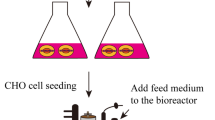Abstract
UCOE vectors contain non-tissue specific chromatin-opening-elements that permit rapid expression of a protein in anintegration independent manner. Efficient expression can bederived from a single copy of an integrated gene site resulting ina higher percentage of cells expressing the marker gene in theselected pool in comparison to standard non-UCOE containingvectors. This, in combination with the utilization of a serum-free, suspension adapted parent cell line allows for rapidproduction of large quantities of protein in a short period oftime. Utilizing this system more than 300 mg of a recombinantantibody has been produced in less than 1 month from transfectionpools in shake flask. Selected subclones have been scaled intosmall bioreactors in less than 2 months, producing significantquantities of monoclonal antibody using a protocol generic for theparent cell line. The increased efficiency obtained with the UCOEvector reduces the number of transfectants which need to bescreened in order to obtain high productivity subclones.Transfection of a standard host cell line, preadapted to grow in alarge-scale setting, allows for rapid cell line developmentdecreasing the transition time from research into development andmanufacturing. Alternatively, the traditional approach of using aparent cell line which requires serum-free and suspensionadaptation after transfection further increases the need forscreening a large number of subclones, because many of thesubclones will not be able to grow under conditions that allowlarge-scale protein production. The use of a preadapted cell linecan reduce the time required to develop a cell line from months toweeks.
Similar content being viewed by others
References
Borrebeack CM & Ohlin M (1993) Does endogenous glycosylation prevent the use of mouse monoclonal antibodies as cancer therapeutics? Immunol Today 14: 477–479.
Cho SK & Cummings RD (1997) A soluble form of α1,3-galactosyltransferase functions within cells to glycosylate proteins. J Biol Chem 272: 13622–13628.
Crombie R & Antoniou M (2000) A Polynucleotide Comprising a Ubiquitous Chromatin Opening Element (UCOE). Patent Number WO0005393, 2000-02-03.
D'Anna JA, Valdez JG, Habbersett RC & Crissman HA (1997) Association of G1/S-Phase and Late S-Phase Checkpoints with Regulation of Cyclin-Dependent Kinases in Chinese Hamster Ovary Cells. Rad Res 148: 260-271.
D'Anna JA, Crissman HA, Valdez JG, Gurley LR & Tobey RA (1996) Syncronization of mammalian cells in S-phase by sequential use of isoleucine-deprivation G1-or serum-withdrawl G0-arrest and aphidicolin block. Meth Cell Sci 18: 115–125.
Deaven LL & Petersen DF (1973) The Chromosomes of CHO, an Aneuploid Chinese Hamster Cell Line: G-Band, C-Band, and Autoradiographic Analysis. Chromosoma 41: 129–144.
Gorelik EL, Anaraki DF & Galili U (1995) Alterations of cell surface carbohydrate and inhibition of metastatic property of murine melanomas by α1,3 galactosyltransferase gene transfection. Cancer Res 55: 4185–4173.
Gorfien SF, Dzimian JL, Tilkins ML, Godwin GP & Fike R (1998) Recombinant Protein Production by CHO Cells Cultures in a Chemically Defined Medium. In: Kitagawa Y, Matsuda T, Iijima S (eds.) Animal Cell Technology: Basic & Applied Aspects. Kluwer Academic Publishers (Netherlands) pp. 247–252.
Kagawa YT, Utsumi S, Hosoi K, Shimizu H, Kochibe N & Kobata A (1988) Comparative study of the asparagines-linked sugar chains of natural human interferon-1 and recombinant human interferon produced by three different mammalian cell lines. J Biol Chem 263: 7508–17515.
Puck TT, Cieciura, SJ & Robinson, A (1958) Genetics of somatic mammalian cells: Long term cultivation of euploid cells from human and animal subjects. J Exp Med 108: 945–955.
Author information
Authors and Affiliations
Rights and permissions
About this article
Cite this article
Benton, T., Chen, T., McEntee, M. et al. The use of UCOE vectors in combination with a preadapted serum free, suspension cell line allows for rapid production of large quantities of protein. Cytotechnology 38, 43–46 (2002). https://doi.org/10.1023/A:1021141712344
Issue Date:
DOI: https://doi.org/10.1023/A:1021141712344




